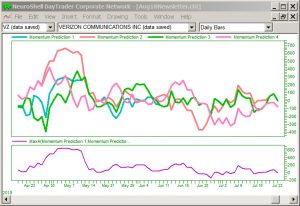August 21, 2018
IN THIS ISSUE
DOES YOUR TRADING SYSTEM AUTOMATICALLY SWITCH TO YOUR BEST MODEL?
WEBINAR OFFER REPEATED
______________________________________________________________________________________________________
by Denham Ward
You’ve probably noticed that some of your models work better on trending markets while others work better in cyclic markets. You can manually switch models based on market conditions, but what if you could automatically switch your trading system according to the maximum value of a selection criteria like Equity, Recent Equity Curve Correlation, Recent Change in Equity, Winners Minus Losers, etc.
The method we are going to demonstrate works for both rule based systems and neural network predictions.
where System1Criteria might be Momentum(SystemEquity(Trading Strategy #1), 10 ) if you wanted the system with the maximum change in equity over the last 10 bars.

Once you have figured out the MaxCriteria value, then you would need to create a controlling trading strategy where each entry/exit condition is nested in a series of IfThenElse rules that select which trading system to use.
System 4 Buy Long Signal
 |
|
|
The Long Entry condition above is the first of four nested rules that compare the 10 period change in equity for Prediction 1 against the max value for all of the predictions in our example chart.
|

The method described above works for ranking different trading systems for a SINGLE security on one chart page.
If you want to balance all of the stocks in your portfolio, check out the model in the July 2018 Newsletter that uses the upper rank indicator. The newsletter is available from our technical support website: NSTSupport.wardsystemsgroup.com.
______________________________________________________________________________________________________
- Preventing Overfitting
- Optimization Tips
- Pattern Recognition is Key
- Automatically Adapting Models to Changing Markets
- How to Use Adaptive TurboProp2, Neural Indicators, and Adaptive Net Indicators
- Different Uses for Averages: Variable Length Moving Avg and Average Trading Rules
- Practical Suggestions: How Much Data, What to Do When a Model Isn’t Working, and Ensemble Models
The cost of the training materials is $179.
